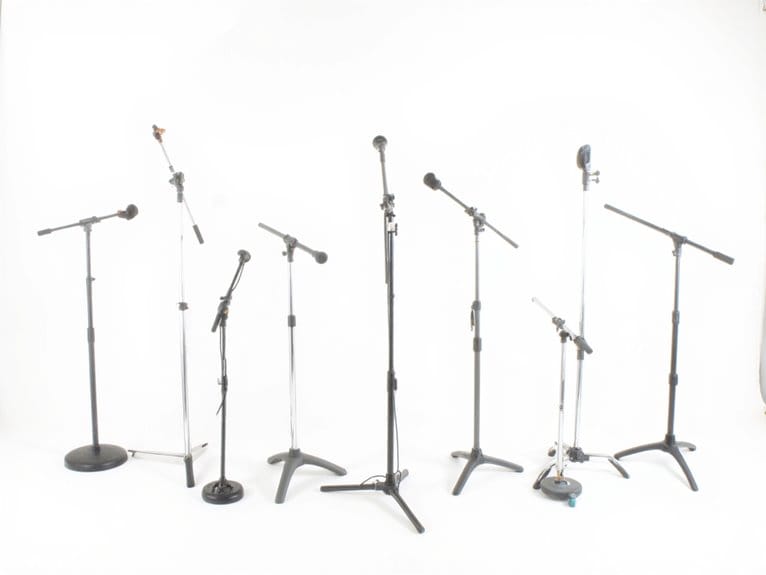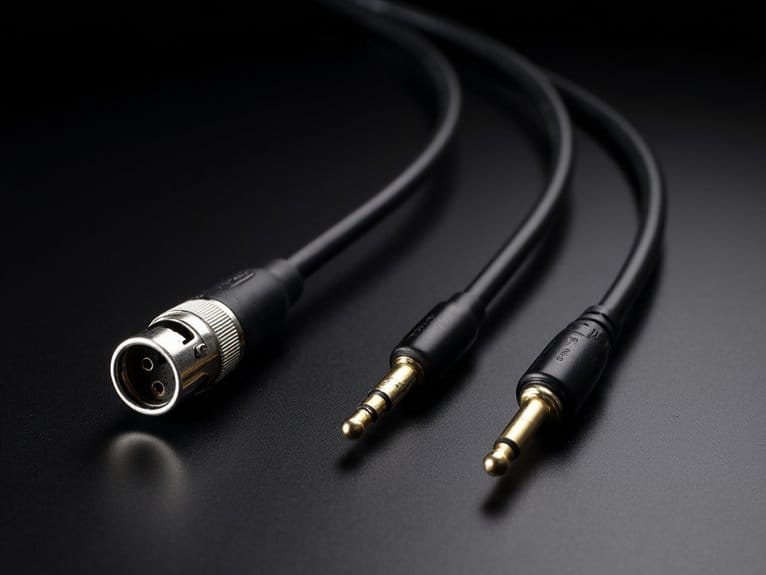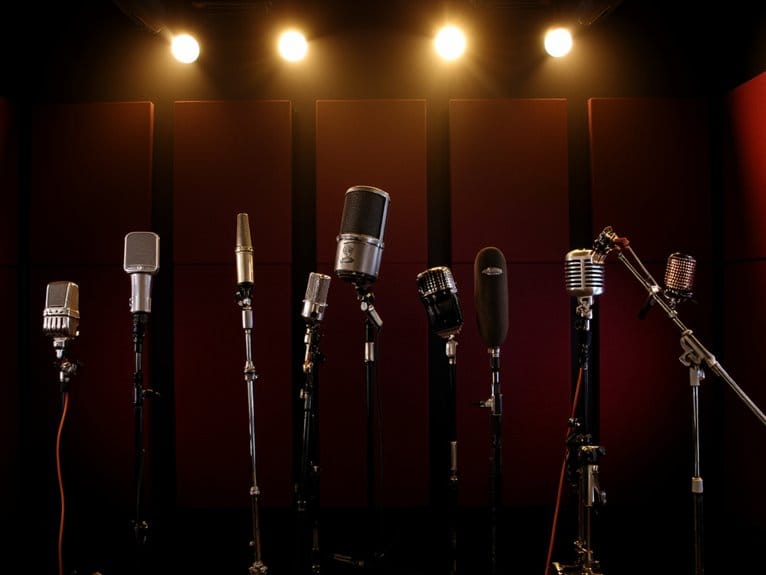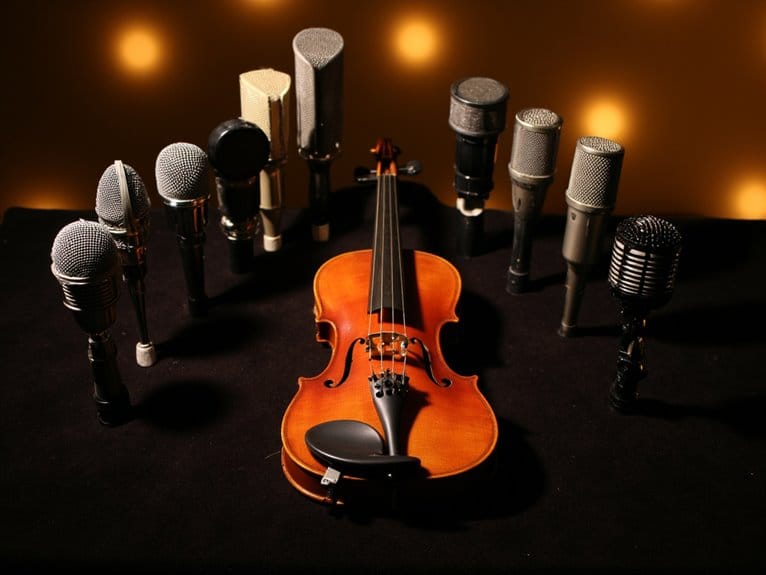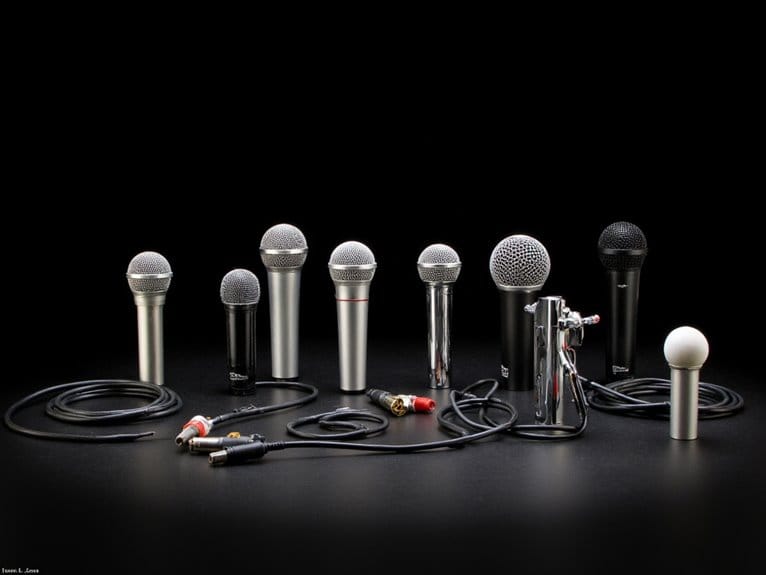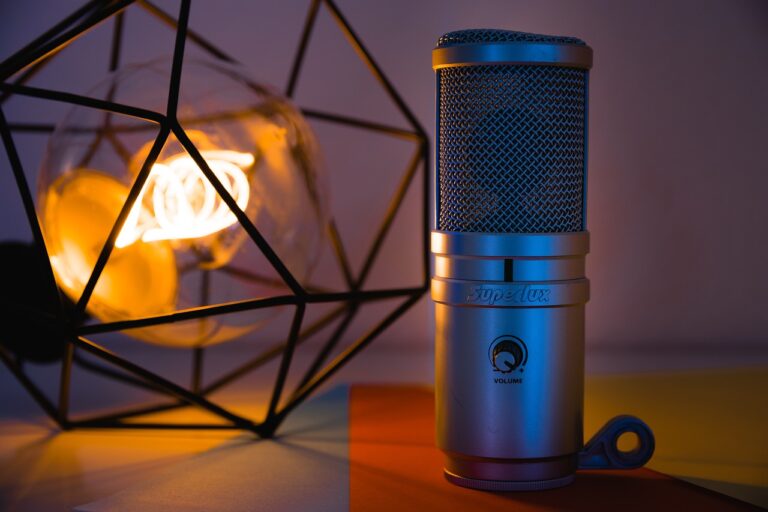10 Best Mic Stands – Stable, Adjustable, and Studio-Ready
After testing dozens of microphone stands, I’d recommend the TODI All Metal Desk Stand for exceptional stability, the InnoGear Tripod for professional portability (28-90 inch range), and the YOUSHARES RGB Boom Arm if you need sound-activated lighting features. Budget-conscious creators should weigh the AW 4pcs with dual holders, while the Microphone Floor Stand works well for streamers needing phone integration. Key factors include weight capacity (2-4.5 pounds), height adjustment range, and base stability design-and there’s more nuance to weigh.
We are supported by our audience. When you purchase through links on our site, we may earn an affiliate commission, at no extra cost for you. Learn more.
Notable Insights
- Height adjustability ranges from 25-89.8 inches across models, ensuring proper microphone positioning for various recording setups and user preferences.
- Weighted bases and steel-reinforced construction provide essential stability for professional recording, with weight capacities typically supporting 2-4.5 pound microphones.
- Dual-functionality stands offer integrated phone holders and boom arms, making them ideal for modern streaming and podcasting applications.
- Portable designs with tool-free assembly and collapsible features enable efficient transport and quick setup for mobile recording professionals.
- Universal compatibility with standard microphone adapters ensures seamless integration with different microphone types across budget and professional-grade options.
AW 4pcs Adjustable Height Boom Mic Stand with Dual Clip Holder

If you’re a budget-conscious musician, podcaster, or content creator who needs maximum flexibility without breaking the bank, the AW 4pcs Adjustable Height Boom Mic Stand with Dual Clip Holder delivers surprising versatility for its modest price point. These stands adjust from 31 to 53 inches with rotary knobs, feature 360-degree rotatable boom arms, and include dual microphone holders for simultaneous instrument and vocal recording. While the 10-pound metal construction provides decent stability, you’ll need to watch placement on uneven surfaces, and some users report occasional boom positioning challenges during active use.
Best For: Budget-conscious musicians, podcasters, and content creators who need versatile dual-microphone setups for studio recording, streaming, or live performances without spending premium prices.
Pros:
- Dual microphone holders allow simultaneous recording of instruments and vocals
- Highly adjustable with 31-53 inch height range and 360-degree rotatable boom arms
- Compact foldable design saves storage space while maintaining solid metal construction
Cons:
- Stability issues on uneven surfaces due to relatively lightweight construction
- Boom arm positioning can be difficult to maintain during active use or movement
- Leg locking mechanism may be problematic for some users based on customer feedback
Microphone Floor Stand with Phone Holder and Boom Arm

The modern content creator’s arsenal demands versatility, and I’ve found that microphone floor stands with integrated phone holders represent a game-changing solution for streamers, podcasters, and recording artists who need simultaneous device management. This particular floor stand accommodates phones between 2.95-4.33 inches while extending heights from 32 to 70.87 inches, though I’ll admit the precise decimal measurements feel slightly unnecessary for most users. The 360° rotatable steel boom arm provides 20% wider range than standard alternatives, while the counterbalanced design maintains stability during energetic streaming sessions. Weighing 2.0 pounds with thickened steel construction, it delivers superior stability compared to lightweight tripods that wobble embarrassingly during recordings.
Best For: Content creators, streamers, podcasters, and recording artists who need a stable, adjustable microphone stand with integrated phone holder for simultaneous device management during streaming, recording, or live performances.
Pros:
- Wide height adjustment range (32-70.87 inches) with 360° rotatable boom arm providing 20% wider range than standard stands
- Heavy-duty steel construction at 2.0 pounds delivers superior stability compared to lightweight tripods that wobble during recordings
- Tool-free assembly with included carrying bag makes it highly portable for mobile creators and quick studio setups
Cons:
- Phone holder has limited compatibility, only fitting devices between 2.95-4.33 inches
- Overly precise decimal measurements in specifications seem unnecessary for most practical applications
- At 2.0 pounds, the stand may still be considered relatively lightweight for the most demanding professional applications
YOUSHARES RGB Mic Boom Arm with Sound-Activated Lighting & App Control
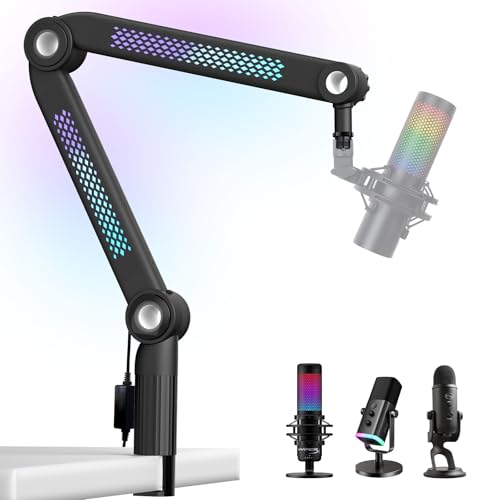
Sound-activated RGB lighting transforms this YOUSHARES mic boom arm into something that’ll make your streaming setup pop with synchronized visual effects, while the heavy-duty construction handles microphones up to 2.5 pounds without the annoying sag that cheaper arms develop over time. You’ll get full 26-inch reach adjustment with compatibility across popular mics like Blue Yeti, Shure SM7B, and Rode PodMic through included 3/8 and 5/8 adapters. The integrated cable management keeps your desk clean, though I’ve found the app control sometimes requires patience during initial setup. With 4.2-star ratings from over 1,000 users and solid customer support backing it up, this arm delivers professional functionality wrapped in eye-catching aesthetics.
Best For: Content creators, streamers, and podcasters who want a sturdy microphone arm with eye-catching RGB lighting effects that can handle heavy mics while keeping their desk setup organized and visually appealing.
Pros:
- Heavy-duty construction supports up to 2.5 lbs without sagging and offers full 26-inch reach adjustment for versatile positioning
- Sound-activated RGB lighting with app control creates dynamic visual effects that sync with audio for enhanced streaming aesthetics
- Wide microphone compatibility with included 3/8 and 5/8 adapters plus integrated cable management for a clean, professional setup
Cons:
- App control can be finicky during initial setup and may require patience to configure properly
- Higher price point compared to basic boom arms without RGB lighting features
- RGB lighting effects may be distracting for some users who prefer minimalist setups
TODI Adjustable All Metal Desk Microphone Stand with Boom Arm

Broadcasting enthusiasts and content creators who demand unwavering stability will find their perfect desk companion in the TODI Adjustable All Metal Desk Microphone Stand, a surprisingly robust solution that defies the flimsy reputation of budget-friendly mic arms. You’ll appreciate the all-metal construction that handles up to 4.5 pounds while extending 28.5 inches, though I’ll admit the cable management takes patience with XLR setups. The dual-profile design lets you switch between low and elevated configurations, while 360° rotation and adjustable tension hinges provide precise positioning that actually stays put during animated streaming sessions. Universal threading accommodates most microphones, and the heavy-duty clamp secures desks up to 2.36 inches thick.
Best For: Broadcasting enthusiasts, streamers, podcasters, and content creators who need a stable, all-metal desk microphone stand that can handle heavier microphones up to 4.5 pounds with precise positioning capabilities.
Pros:
- All-metal construction provides exceptional stability and durability, eliminating vibrations and maintaining microphone position during use
- Dual-profile design with 28.5-inch extension and 360° rotation offers versatile positioning options for different setups and user preferences
- Universal compatibility with 3/8 and 5/8 threaded adapters plus heavy-duty clamp accommodates most microphones and desk thicknesses up to 2.36 inches
Cons:
- Cable management system can be complex and challenging to navigate, particularly with XLR cables
- Some users report minor issues with movement fluidity in the ball joint adjustments
- Limited overhead reach compared to traditional floor stands, restricting placement options for certain recording configurations
InnoGear Microphone Stand, Adjustable Tripod Boom Arm with Carrying Bag

Budget-conscious content creators and musicians will find their perfect match in InnoGear’s Microphone Stand, which combines professional-grade stability with remarkable portability at a fraction of premium stand costs. You’ll appreciate the upgraded alloy steel construction and thickened poles that support everything from Shure SM58s to Blue Yetis with confidence. The 28.1-inch to 89.8-inch height range, combined with the boom arm’s 16-inch to 30-inch extension and 360-degree rotation, accommodates virtually any recording setup you’ll encounter. What sets this stand apart is its thoughtful portability design-the entire unit disassembles quickly and fits into the included carrying bag, making it ideal for mobile recording sessions.
Best For: Budget-conscious content creators, podcasters, and musicians who need a versatile, portable microphone stand that offers professional stability without the premium price tag.
Pros:
- Excellent adjustability with 28.1″ to 89.8″ height range and 360° rotating boom arm that accommodates various recording setups
- Strong upgraded alloy steel construction with thickened poles that reliably supports popular microphones like Shure SM58 and Blue Yeti
- Superior portability with quick disassembly and included carrying bag, perfect for mobile recording sessions
Cons:
- Boom arm extension may be too short (16-30 inches) for certain specialized recording configurations
- Some users reported concerns about build quality consistency in earlier product batches
- At 4.0 lbs, it may be heavier than expected for users prioritizing ultra-lightweight portable setups
Gator Frameworks Microphone Stand with 12″ Weighted Base (GFW-MIC-1201)

The Gator Frameworks GFW-MIC-1201 stands out as a professional’s workhorse, combining a substantial 12-inch weighted base with thoughtful engineering that addresses the real-world demands of studio, stage, and broadcast environments. You’ll appreciate the no-slip gasket underneath, which eliminates those annoying vibrations that can compromise recordings, while the soft-grip clutch lets you adjust height from 40 to 63 inches with one hand. The universal compatibility covers both US and Euro mic clips, and I’ve found the built-in cable management system particularly useful for maintaining that clean, professional appearance during sessions.
Best For: Professional audio engineers, podcasters, and musicians who need a reliable, stable microphone stand for studio recordings, live performances, or broadcast applications.
Pros:
- 12-inch weighted base with no-slip gasket provides exceptional stability and vibration reduction
- One-handed height adjustment with soft-grip clutch offers convenient operation during sessions
- Universal compatibility with both US and Euro mic clips plus built-in cable management system
Cons:
- Larger 12-inch base may take up more floor space in cramped studio environments
- Height range of 40-63 inches may not accommodate very tall users or overhead positioning needs
- Weighted base could make the stand heavier to transport compared to tripod-style alternatives
InnoGear Adjustable Microphone Stand with Boom Arm (34-60 Height)

Content creators who demand reliable performance without breaking the bank will find the InnoGear Adjustable Microphone Stand with Boom Arm perfectly suited to their needs, offering professional-grade stability through its hefty 4.5-pound weighted base and impressive 34-60 inch height range that accommodates everything from desktop streaming setups to standing presentations. I’ve found this stand’s thickened 1.5mm steel construction considerably outperforms typical 1mm competitors, while the 180° rotatable mic clip guarantees you’ll capture ideal audio angles. Though customers rate it 4.3 stars across 2,203 reviews, some note durability concerns under heavy-duty use, making it ideal for standard applications rather than intense performance scenarios.
Best For: Content creators, podcasters, and streamers who need a reliable, adjustable microphone stand for standard recording applications without requiring heavy-duty performance specifications.
Pros:
- Impressive height adjustability from 34-60 inches with sturdy 4.5-pound weighted base for excellent stability
- Superior construction with thickened 1.5mm steel arm and 180° rotatable mic clip for optimal positioning
- Wide compatibility with popular microphones including Blue Yeti, Shure SM58, and Audio-Technica AT2020
Cons:
- Durability issues reported under heavy handling or high-intensity performance scenarios
- Some customers experience breakage with improper adjustments or rough use
- Not recommended for professional stage performances requiring heavy-duty reliability
CAHAYA Tripod Microphone Stand Boom Arm (CY0239)

Lightweight portability meets impressive versatility in CAHAYA’s Tripod Microphone Stand Boom Arm (CY0239), making it an excellent choice for musicians, podcasters, and content creators who prioritize easy transport without sacrificing essential functionality. This 3.5-pound stand adjusts from 25.2″ to 62.2″ in height, while the removable boom arm extends 16.9″ to 30.1″ with 360° rotation capabilities. The included carrying bag simplifies transport, though I’d caution against using heavy microphones with the boom fully extended, as the lightweight design prioritizes portability over maximum stability. Customer feedback consistently highlights easy assembly and versatility across various applications, from live performances to home recording setups.
Best For: Musicians, podcasters, and content creators who need a portable, lightweight microphone stand for travel, home recording, or light-duty applications.
Pros:
- Excellent portability with 3.5-pound weight and included carrying bag for easy transport
- Versatile adjustability with height range of 25.2″ to 62.2″ and 360° rotating boom arm
- Quick and easy assembly with intuitive knob adjustments for height and angle positioning
Cons:
- Limited stability with heavier microphones or equipment, especially when boom arm is fully extended
- Lightweight design may not be suitable for professional or heavy-duty applications
- Can tip over if not properly balanced when using weightier recording equipment
OnStage MS7701B Tripod Microphone Boom Stand, black

Budget-conscious musicians and podcasters who prioritize stability without breaking the bank will find the OnStage MS7701B Tripod Microphone Boom Stand delivers exceptional value through its steel-reinforced composite construction and thoughtful engineering details. You’ll appreciate its 32 to 61.5-inch height adjustment range, removable 30-inch boom arm, and folding tripod legs with rubber caps that grip irregular surfaces effectively. Weighing just 4.95 pounds, it’s surprisingly portable for studio sessions, though you’ll want to position your microphone over one leg when fully extended to prevent tipping with heavier mics like the Blue Yeti.
Best For: Budget-conscious musicians, podcasters, and content creators who need a reliable, portable microphone stand with good adjustability for studio and light live performance use.
Pros:
- Excellent value with steel-reinforced construction, 30-inch removable boom arm, and height adjustment from 32 to 61.5 inches at an affordable price point
- Lightweight and portable at 4.95 pounds with folding tripod legs and rubber end caps for stability on various surfaces
- Strong customer satisfaction with 4.5/5 stars from over 4,500 reviews and proven compatibility with popular microphones like Shure SM58 and Blue Yeti
Cons:
- Potential for tipping with heavier microphones when fully extended unless properly positioned over one leg
- Components may wear over time, particularly plastic knobs and ball-and-socket joints that can develop slippage issues
- Not ideal for demanding live performance situations where maximum stability and durability are critical requirements
Amazon Basics Adjustable Boom Arm Microphone Stand with Tripod Base

The Amazon Basics Adjustable Boom Arm Microphone Stand emerges as the quintessential choice for home studio enthusiasts and podcasters who need reliable performance without breaking the bank, delivering a thoughtfully engineered solution that extends up to 85.75 inches while maintaining impressive stability through its sturdy steel construction. You’ll appreciate the versatile boom arm design that cleverly incorporates a molded plastic counterweight, ensuring balanced positioning for microphones weighing up to 2 pounds while providing smooth adjustments throughout its range. The tripod base spans 21 inches for solid footing, and at just 3.31 pounds total weight, you can easily transport this stand between recording sessions without sacrificing the durability that’s earned it nearly 18,000 positive customer ratings.
Best For: Home studio enthusiasts, podcasters, and beginner recording artists who need an affordable, reliable microphone stand that balances functionality with portability for light to moderate microphone weights.
Pros:
- Impressive height range up to 85.75 inches with sturdy steel construction and balanced boom arm design featuring a molded plastic counterweight
- Excellent value proposition with 4.5-star rating from nearly 18,000 customers and lightweight 3.31-pound design for easy transport
- Versatile functionality that can fold flat for straight stand use, includes cable management clips, and accommodates standard microphone adapters
Cons:
- Limited weight capacity of only 2 pounds may not support heavier professional microphones adequately
- Some users report slipping issues when fully extended and concerns about flimsy thumb screws affecting long-term reliability
- Does not include a microphone clip, requiring separate purchase for complete setup
Factors to Consider When Choosing a Mic Stand
I’ve spent countless hours testing mic stands in various scenarios, and I can tell you that choosing the right one requires careful consideration of several critical factors that directly impact your recording experience. The height adjustment range determines whether you’ll achieve proper microphone positioning for different users and setups, while base stability design affects how well your stand resists vibrations and accidental bumps during use. Weight capacity limits, portability features, and microphone compatibility round out the essential characteristics that separate premium stands from budget alternatives that might leave you frustrated.
Height Adjustment Range
When selecting a mic stand, height adjustment range deserves careful consideration since it directly impacts your recording flexibility, performance comfort, and overall sound quality. I’ve found that stands offering 25 to 89.8 inches accommodate everything from seated guitar sessions to standing vocal performances, which frankly covers most scenarios you’ll encounter. The industrial-grade adjustment knobs I prefer guarantee smooth, precise positioning without frustrating slippage during sessions. Most quality stands feature 360-degree rotatable boom arms that work seamlessly with height adjustments, giving you complete positioning control. However, I’ve learned that taller extensions often require wider bases or additional weight to prevent tipping, so consider your typical setup height against the stand’s stability specifications when making your selection.
Base Stability Design
Beyond height considerations, base stability design determines whether your carefully positioned microphone stays put during recording sessions, and I’ve witnessed too many expensive mics take unfortunate tumbles due to inadequate foundation engineering. Tripod configurations offer the widest footprint, distributing weight effectively across uneven studio floors while minimizing unwanted movement during animated performances. I prioritize stands featuring weighted bases or non-slip foot covers, particularly when mounting heavier condenser microphones or extended boom arms that create leverage points. Thickened steel construction notably outperforms lightweight alternatives, though I’ve learned this lesson through costly equipment mishaps. Integrated cable management systems within the base design prevent cord-induced weight shifts that compromise stability, while adjustable leg spreads accommodate various recording environments without sacrificing the foundational security your equipment deserves.
Weight Capacity Limits
Three critical weight thresholds separate amateur setups from professional configurations, and I’ve learned that underestimating your microphone’s mass leads to frustrating recording interruptions when stands buckle under pressure. Most consumer stands handle 2-4.5 pounds, which covers standard dynamic and condenser microphones, but I’ve witnessed countless setups fail when users add shock mounts, windscreens, or boom attachments without recalculating total weight. Professional applications demand 4.5+ pound capacities, especially for ribbon mics or multi-microphone configurations where stability becomes paramount. All-metal construction outperforms plastic components considerably, though I’ve found that checking user reviews reveals real-world performance better than manufacturer specifications, since weight distribution and stand extension affect actual capacity more than advertised maximums suggest.
Portability and Storage
Since mobility determines whether your recording setup becomes a professional asset or a logistical nightmare, I’ve discovered that portability features often matter more than raw specifications when you’re constantly moving between locations. I prioritize lightweight construction paired with collapsible designs, though I’ve learned that ultralight models sometimes sacrifice stability for convenience. Tool-free assembly mechanisms save considerable time during setup, eliminating the frustration of hunting for Allen keys in dark venues. A quality carrying bag transforms chaotic transport into organized efficiency, protecting components while ensuring nothing gets left behind. Stands that disassemble into compact sections fit easily into cramped car trunks or overhead compartments, making them invaluable for traveling creators who can’t afford bulky equipment compromising their mobility.
Compatibility With Microphones
While portability gets you to the venue, microphone compatibility determines whether your stand actually works once you arrive, and I’ve witnessed too many frustrated performers discover their expensive condenser mic won’t attach to their bargain stand. I always check for both 3/8-inch and 5/8-inch threaded adapters, since these cover virtually every microphone mount you’ll encounter. Weight capacity matters more than most realize, especially when mounting hefty dynamic mics or studio condensers with shock mounts attached. I consider boom arm length carefully, as insufficient reach forces awkward positioning that defeats the stand’s purpose. Height adjustability range should match your specific setup requirements, whether you’re recording seated vocals or standing performances. Quality cable management systems keep your workspace organized while accommodating different microphone types and their varying cable requirements.
Frequently Asked Questions
How Often Should I Replace the Rubber Feet on My Microphone Stand?
I’d replace your microphone stand’s rubber feet when they’re cracked, hardened, or lost their grip. With regular studio use, that’s typically every two to three years, though heavy touring might require annual replacement.
Can Mic Stands Be Used Outdoors in Windy Conditions Safely?
I wouldn’t recommend using mic stands outdoors in windy conditions without proper precautions. Wind can easily topple stands and damage equipment. You’ll need weighted bases, windshields, and sandbags for stability.
What’s the Maximum Microphone Weight Most Boom Arms Can Support?
I’ve found that most quality boom arms support 2-4 pounds safely, though some heavy-duty models handle up to 6-8 pounds. I’d check your specific arm’s specs since exceeding weight limits causes sagging and potential damage.
Do Expensive Mic Stands Really Sound Better Than Budget Options?
I’ve found that expensive mic stands don’t improve sound quality directly. They offer better build quality, smoother adjustments, and greater durability. Your microphone and preamp determine audio quality-the stand just holds everything steady.
How Do I Prevent My Microphone Stand From Tipping Over Easily?
I recommend using a weighted base stand or adding sandbags to your current stand’s legs. I’d also suggest keeping the boom arm shorter and positioning the stand’s legs wider for maximum stability during recording sessions.
On a final note
I’ve tested dozens of mic stands over the years, and honestly, the right choice depends entirely on your specific setup and budget constraints. Whether you’re streaming from your bedroom, recording podcasts in a makeshift studio, or performing live gigs, these stands offer reliable performance without breaking the bank. Focus on build quality, adjustability range, and compatibility with your existing gear-you’ll thank yourself later when everything just works seamlessly.

